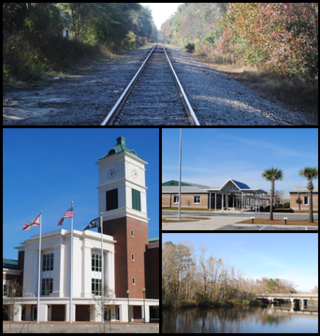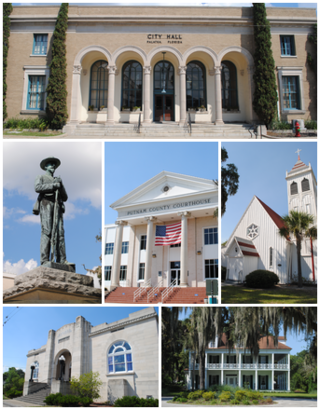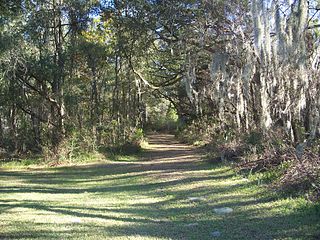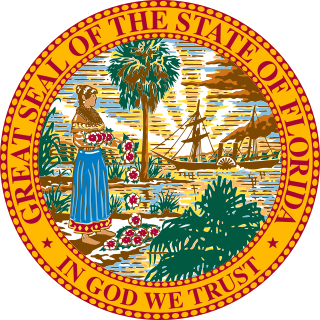
Putnam County is a county located in the northern part of the state of Florida. As of the 2020 census, the population was 73,321. Its county seat is Palatka.

Yulee is a Census County Division (CCD) located within Nassau County, Florida, in the United States. Positioned in northeastern Florida, Yulee lies directly south of the Florida-Georgia state line, marked by the St. Marys River. Furthermore, it is situated 24 miles north of downtown Jacksonville, Florida. As of the latest survey conducted by the U.S. Census Bureau in 2021, the CCD's population is recorded at 36,742. Yulee is a constituent of the Jacksonville metropolitan area, which encompasses an estimated population of approximately 1.68 million individuals as of 2022. Presently, the Yulee Census County Division serves as a residential bedroom community for individuals commuting to Jacksonville, Naval Submarine Base Kings Bay, and various locations in Southeast Georgia. It is also actively engaged in efforts to broaden its tax base for economic diversification.

Palatka is a city in and the county seat of Putnam County, Florida, United States. Palatka is the principal city of the Palatka Micropolitan Statistical Area, which is home to 72,893 residents. The city is also home to St. Johns River State College, St. Johns River Water Management District Headquarters, and Ravine Gardens State Park. The area is well known for its local festivals, most notably the Florida Azalea Festival and the Blue Crab Festival. The population was 10,446 at the 2020 census.

The St. Johns River is the longest river in the U.S. state of Florida and it is the most significant one for commercial and recreational use. At 310 miles (500 km) long, it flows north and winds through or borders twelve counties. The drop in elevation from headwaters to mouth is less than 30 feet (9 m); like most Florida waterways, the St. Johns has a very slow flow speed of 0.3 mph (0.13 m/s), and is often described as "lazy".

Lionel Alexander Tate is the youngest American citizen ever sentenced to life imprisonment without the possibility of parole, though this sentence was eventually overturned. In January 2001, when Tate was 13, he was convicted of first-degree murder for the 1999 battering death of six-year-old Tiffany Eunick in Broward County, Florida.

The Marjorie Harris Carr Cross Florida Greenway is a protected green belt corridor, more than one and a half miles (1.6 km) wide in places, that was the former route of the proposed Cross Florida Barge Canal. It is named for the leader of opposition to the Cross Florida Barge Canal, Marjorie Harris Carr, and was originally a U.S. Army Corps of Engineers canal project to connect the Gulf of Mexico and the Atlantic Ocean across Florida for barge traffic. Two sections were built, but the project was ultimately cancelled because of local opposition related to environmental concerns, including protecting the state's water supply and conservation of the Ocklawaha River Valley ecosystem, as well as national opposition for the costs being perceived as "government waste" with "limited national value." The greenway is part of the system of Florida State Parks, including the Santos Trail System, and is managed by the Florida Department of Environmental Protection.

The government of Florida is established and operated according to the Constitution of Florida and is composed of three branches of government: the executive branch consisting of the governor of Florida and the other elected and appointed constitutional officers; the legislative branch, the Florida Legislature, consisting of the Senate and House; and the judicial branch consisting of the Supreme Court of Florida and lower courts. The state also allows direct participation of the electorate by initiative, referendum, and ratification.

The 74-mile-long (119 km) Ocklawaha River flows north from central Florida until it joins the St. Johns River near Palatka. Its name is derived from ak-lowahe, Creek for "muddy".

The Jacksonville Metropolitan Area, also called the First Coast, Metro Jacksonville, or Northeast Florida, is the metropolitan area centered on the principal city of Jacksonville, Florida and including the First Coast of North Florida. As of the 2020 United States census, the total population was 1,605,848. The Jacksonville–Kingsland–Palatka, FL–GA Combined Statistical Area (CSA) had a population of 1,733,937 in 2020 and was the 34th largest CSA in the United States. The Jacksonville metropolitan area is the 40th largest in the country and the fourth largest in the State of Florida, behind the Miami, Tampa, and Orlando metropolitan areas.
The Florida Public Service Commission (FPSC) regulates investor-owned electric, natural gas, and water and wastewater utilities. The FPSC facilitates competitive markets in the telecommunications industry, has authority over intercarrier disputes, and oversees pay telephones, the federal Lifeline Assistance Program and Telecommunications Relay Service.

The Lake George State Forest is a designated protected area and state forest in the U.S. state of Florida. The 21,176-acre (8,570 ha) forest is located in northwestern Volusia County, Florida, near Lake George and the communities of Pierson, Barberville, and Volusia. It is overseen by the Florida Forest Service within the Florida Department of Agriculture and Consumer Services.
The Florida Mental Health Act of 1971, commonly known as the "Baker Act," allows for a) short-term, inpatient voluntary and involuntary examination, b) inpatient voluntary and involuntary admission of an individual for assessment and treatment of a mental illness, and c) involuntary outpatient treatment for mental illness.

The Florida Department of Environmental Protection (FDEP) is the Florida government agency responsible for environmental protection.
The statutory and fiduciary mandate of the State Board of Administration of Florida (SBA) is to invest, manage and safeguard assets of the Florida Retirement System (FRS) Trust Fund as well as the assets of a variety of other funds. The SBA manages 25 different investment funds and trust clients.
Orange Creek is a small stream in north-central and northeast Florida, that drains Orange Lake to the Ocklawaha River. Privately owned Orange Springs provides part of the water volume.

The Okeehumkee, also known as "Queen of the Ocklawaha River," was a river steamboat that provided transportation along Florida rivers in the late 19th century. The Okeehumkee was equipped with a paddle wheel positioned in the lower stern part of the boat which allowed it to traverse narrow and shallow rivers. The steamboat was the longest-serving craft of its type on the Ocklawaha River route, remaining in service for 43 years.
The Northeast Florida Regional Transportation Commission (NEFRTC) was a government agency located in the U.S. state of Florida. Established June 14, 2013, the purpose of the agency was to coordinate and advance the planning, project development and implementation of regional transportation facilities and services in Baker, Clay, Duval, Nassau, Putnam, and St. Johns Counties.

Local governments are established by the government of Florida and are given varying amounts of non-exclusive authority over their jurisdictions. The law governing the creation of these governments is contained both within the Florida Constitution and Florida Statutes. Local governments are incorporated in Florida by special acts of the Florida Legislature. There are four types of local governments in Florida: counties, municipalities, school districts, and special districts.

University of Florida Historic St. Augustine, Inc. (UFHSA) is located at 48 King Street in St. Augustine, Florida. University of Florida encourages UFHSA to preserve and interpret state owned properties in St. Augustine that will in turn satisfy and support state needs of professionals in historic preservation, archaeology, cultural resources management, cultural tourism, history, and museum administration. UFHSA also seeks to meet the needs of locals in the state of Florida and in the city of St. Augustine, supporting educational internships and practicums.















